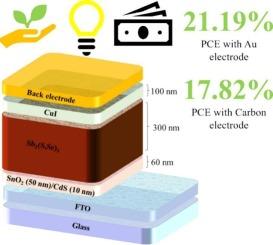Sb2(S,Se)3/CuI平面异质结太阳能电池的光电性能增强:来自器件仿真的见解
IF 4.6
2区 物理与天体物理
Q2 MATERIALS SCIENCE, MULTIDISCIPLINARY
引用次数: 0
摘要
在最先进的Sb2(S,Se)3太阳能电池中,吸收剂被夹在有毒的cds和昂贵的Spiro-OMeTAD之间,分别作为电子和空穴传输层(ETLandHTL)。遵循当前绿色化学的趋势,要么减少上述材料的使用,要么找到它们的替代品是至关重要的。在此背景下,本研究探讨了在Sb2(S,Se)3太阳能电池中使用SnO2/CdS双分子层(ETL)和CuI (HTL)的可行性。仿真结果表明,用SnO2/CdS双分子层取代CdS可使光电流提高2 mAcm-2,而用CuI取代Spiro-OMeTAD可使光电压提高100mV。结果表明,基于Au电极和碳电极的优化器件的PCE分别为21.19%和17.82%。这项工作证实了CuI是Sb2(S,Se)3吸收层的高效异质结伙伴,并为制造高效(PCE>20%)和具有成本效益的Sb2(S,Se)3太阳能电池提供了重要见解。本文章由计算机程序翻译,如有差异,请以英文原文为准。

Enhanced photovoltaic performance in Sb2(S,Se)3/CuI planar-heterojunction solar cells: Insights from device simulation
In state-of-the-art solar cells, the absorber is sandwiched between toxic- and expensive , serving as electron and hole transport layers (), respectively. Adhering to the current trend in green chemistry, it is crucial to either reduce the usage of aforementioned materials or find their alternatives. In this context, this work investigates the feasibility of employing bilayer and ( in solar cells. The simulation results reveal that substituting with bilayer can potentially improve photocurrent by 2 , while with can boost photovoltage by . Consequently, a of and 17.82 % was demonstrated in optimized devices, based on and Carbon electrode, respectively. This work endorses as an efficient heterojunction partner with absorber layer and provides critical insights for the fabrication of highly efficient and cost-effective solar cells.
求助全文
通过发布文献求助,成功后即可免费获取论文全文。
去求助
来源期刊

Results in Physics
MATERIALS SCIENCE, MULTIDISCIPLINARYPHYSIC-PHYSICS, MULTIDISCIPLINARY
CiteScore
8.70
自引率
9.40%
发文量
754
审稿时长
50 days
期刊介绍:
Results in Physics is an open access journal offering authors the opportunity to publish in all fundamental and interdisciplinary areas of physics, materials science, and applied physics. Papers of a theoretical, computational, and experimental nature are all welcome. Results in Physics accepts papers that are scientifically sound, technically correct and provide valuable new knowledge to the physics community. Topics such as three-dimensional flow and magnetohydrodynamics are not within the scope of Results in Physics.
Results in Physics welcomes three types of papers:
1. Full research papers
2. Microarticles: very short papers, no longer than two pages. They may consist of a single, but well-described piece of information, such as:
- Data and/or a plot plus a description
- Description of a new method or instrumentation
- Negative results
- Concept or design study
3. Letters to the Editor: Letters discussing a recent article published in Results in Physics are welcome. These are objective, constructive, or educational critiques of papers published in Results in Physics. Accepted letters will be sent to the author of the original paper for a response. Each letter and response is published together. Letters should be received within 8 weeks of the article''s publication. They should not exceed 750 words of text and 10 references.
 求助内容:
求助内容: 应助结果提醒方式:
应助结果提醒方式:


